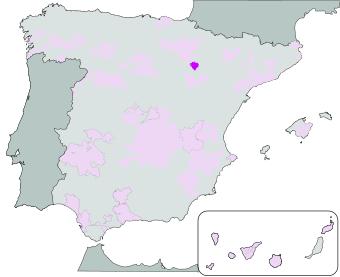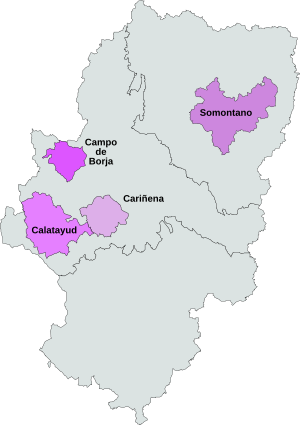Campo de Borja (DO) facts for kids
| Wine region | |

|
|
| Official name | D.O.P Campo de Borja |
|---|---|
| Type | Denominación de Origen Protegida (DOP) |
| Year established | 1977 |
| Country | Spain |
| No. of vineyards | 6,242 hectares (15,424 acres) |
| No. of wineries | 18 |
| Wine produced | 248,509 hectolitres |
| Comments | Data for 2016 / 2017 |

Campo de Borja is a special area in Spain known for making delicious wines. It has a special official status called a Denominación de Origen Protegida (DOP). This means its wines follow strict rules to ensure their quality.
The region is in the northwest part of the Zaragoza province, in Aragon. It's a unique place between the flat lands of the Ebro River and the mountains of the Sistema Ibérico.
The Campo de Borja DOP includes 16 towns. The big Moncayo mountain nearby helps create a special local weather pattern. This weather gives the wines their unique and special taste.
Contents
History of Campo de Borja Wines
People believe that the ancient Romans started growing grapes here a long time ago. The first written record about vineyards in this area is from the year 1203. It was found in the old papers of the Cistercian Monastery of Veruela.
During the centuries when Arabs ruled parts of Spain, less wine was made. But after Christian forces took back the land, wine production grew again.
In the 1400s, the Veruela Monastery became very important for wine. The abbots (leaders) of the monastery bought a lot of land and planted grapevines. Records show that in 1453, they even bought an entire town, Ainzón, with all its fields and vineyards!
This monastery was very important for wine making until the 1800s. It helped replant the whole area after a plant disease called phylloxera damaged many grapevines.
The Campo de Borja area was officially recognized as a Denominación de Origen in 1980. This meant its wines had a special protected status.
Climate and Weather
The weather in Campo de Borja is mostly continental. This means it has big temperature changes between summer and winter. In winter, a cold, dry wind from the northwest blows in from the Atlantic Ocean.
In summer, the weather is influenced by the Mediterranean Sea. Temperatures can change a lot, not just between seasons but also between day and night.
The area doesn't get much rain. The lower parts get about 350 mm of rain each year, and higher areas get around 450 mm. The vineyards are planted on high flat areas, between 350 and 750 meters above sea level.
Soils of the Vineyards
The soils in Campo de Borja are mostly dark and contain lime. They are not too rocky and drain water well. These soils have a good amount of nutrients for the grapevines.
Closer to the Moncayo mountain, the soil has more clay and iron. It also becomes rockier in those areas.
Grape Vineyards
Today, there are about 6,300 hectares (about 15,500 acres) of land planted with grapevines. These vineyards produce between 20 and 25 million kilograms of grapes each year.
The grapevines are grown in two main ways. Some are grown as low bushes, called en vaso. Others are grown on trellises, which are like frames that support the vines, called en espaldera.
Approved Grape Varieties
Only certain types of grapes are allowed to be grown in Campo de Borja for its special wines.
- White Grapes:
- Macabeo
- Garnacha Blanca
- Chardonnay
- Moscatel de Alejandría
- Sauvignon Blanc
- Verdejo
Types of Wines Produced
Campo de Borja makes several types of wines:
- White Wines: These are made using 100% Macabeo grapes. They must have at least 11% alcohol.
- Rosé Wines: These pink wines are made from Garnacha grapes. They must have at least 11% alcohol.
- Young Red Wines: These can be made entirely from Garnacha grapes. They can also be a mix of Garnacha, Tempranillo, and Cabernet Sauvignon. They must have at least 12% alcohol.
- Crianza Wines: These red wines are aged for at least 24 months (2 years). They must have at least 12.5% alcohol.
- Reserva Wines: These red wines are aged for at least 12 months in oak barrels. Then, they are aged for another 24 months (2 years) in bottles. They must have at least 12.5% alcohol.
- Gran Reserva Wines: These red wines are aged for at least 24 months (2 years) in oak barrels. After that, they are aged for another 36 months (3 years) in bottles. They must have at least 12.5% alcohol.
- Other Wines: The region also produces sweet wines called Mistelas and dessert wines from Moscatel grapes. Sparkling wine is also made here. These special wines must have at least 15% alcohol.
See also
 In Spanish: Campo de Borja (vino) para niños
In Spanish: Campo de Borja (vino) para niños

